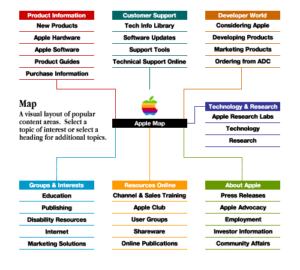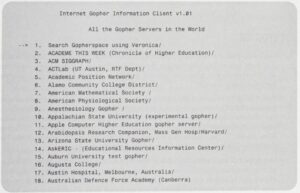Last updated on February 9, 2025
When I was looking through Apple’s reference CDs I read a note in the 1997 Service Source v2.5 CD that stated all future documents would only be on Apple’s website. Reading that note made me wonder when Apple launched it’s first website. I thought that would be an easy fact to find, but I’ve yet to find a specific date, but have been able to narrow it down to June of 1994.
I was fortunate to see the internet as we know it come in to existence. I started classes at the University of Waterloo in September 1992, so I had access to CA*net (which evolved from 1983 OnNET, then 1984 NetNorth to 1989 CA*net). CA*net connected Canadian universities and other research institutions in Canada to the United State’s The National Science Foundation Network (1985 BITNET, 1989 BITNET merged with CSNET to form CREN, 1991 CREN retired and replaced by NSFNet) and through the NSFNet links to systems around the world. I used Gopher (released mid-1991) and Lynx (released mid-1992) when I started university, then later used the Mosaic browser (released 1993), then Netscape (beta late 1994), then IE (1995) for the brief time it was better than Netscape. For Mosaic, I remember using an early version on X-windows, but didn’t use it much until it was ported Microsoft Windows in mid 1993. Early in 1994 I finally got around to creating my first webpage hosted on my University of Waterloo UNIX account with it’s 256 colour dithered GIF images.
1994 June? Apple launches it’s first website
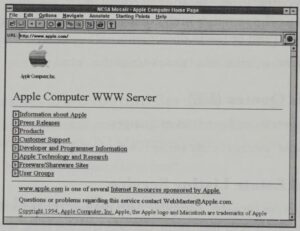
As I mentioned in my intro, I haven’t been able to find the exact date when Apple launched it’s first public website, but I think I have been able to narrow it down to June 1994.
I know it was after February 1994 based on the article “The Rest of the Story” by Andy Ihnatko in Mac User’s September 1994 edition that states:
Back in February, I wrote about some of Apple’s free Internet resources. Since then Apple has set up an excruciatingly spiffy new home page http://www.apple.com on the World Wide Web. For those of you that have never heard of a home page, it’s an on-line-readable hypertext document….”
“The Rest of the Story” by Andy Ihnatko in Mac User’s September 1994 edition
I think the launch date was May not March or April based on TidBITS’s July 4th 1994 article Apple Internet Plans? that states:
New Web Server — Speaking of Gopher and Web services, Apple has had a Gopher server up and running for some time at: gopher://info.hed.apple.com. However, in keeping up with the Internet, Apple recently added a Web server as well at: http://www.apple.com. The Web site has links to other Apple Internet resources and information related to Apple (and much more promised).
TidBITS’s July 4th 1994 article Apple Internet Plans?
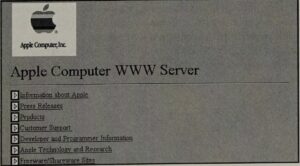
Those two sources narrowed down the date to between February 1994 and July 4th 1994.
And I believe the launch date to be in June based on the screen shots in the book: Internet Start Kit for Macintosh 2nd Edition by Adam C Engst. Many of the screen shots are from June 11th or earlier, and the book mentions Apple’s FTP site on page 222, @applelink.apple.com emails on page 250, Apple’s new eWorld Service on page 262, Mosaic 2.0a1 on page 736 and MacWeb 0.98a on page 742, and provides screenshots of other websites and tools, but the only mention I found of Apple’s website was in the Appendix on page 792, so I’m assuming the text was added just before the content was finalized.
Apple itself has put a World-Wide Web server on the Internet. It offers information about Apple products, connections to resources useful to Mac programmers, and Apple press releases. Additional links describe new products and provide access to Apple-oriented resources and the Apple Library of Tomorrow.
Internet Start Kit for Macintosh 2nd Edition by Adam C Engst on page 792
The the 3rd Edition from 1995 does include a screenshot of Apple’s Site on page 611 (advertising the new QuickTake 150) showing the metallic gray layout I mention later on this page.
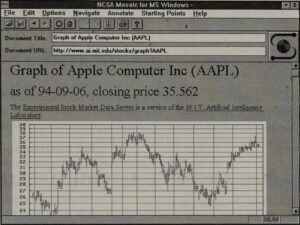
For what Apple’s site looked like when in launched, the oldest image I’ve been able to find so far is from August 1994 (figure 1).
For the date of the second screenshot of Apple’s website (figure 2), I believe it is from around the same date as the Sept 6th, 1994 snapshot of the stock value (figure 3) from the same book.
If so, these two screen shots are the oldest anyone has posted online so far, and they pre-date the very colorful version found on the version museum.
The book states that at the time the screen shot was taken the main menu offered:
- Information about Apple
- Press releases
- Products
- Customer support
- Developer and programmer information
- Apple technology and research
- Freeware / shareware sites
- User groups
- Internet resources sponsored by apple.
About 50 percent of the links opened HTML documents and the other half connected to Gopher menus.
Note: MacWorld’s August 1994 article Macworld’s guide to Online Services states that access to the internet is still very limited at the time, so the number of user’s accessing Apple’s website was probably fairly limited. For MacWorld December 1994, Taming the Internet, I was surprised but there is no mention of Apple’s new homepage that was mentioned by Macuser in September.
1994 August: Apple’s website described in Info Alley
Information Alley was a bimonthly (twice a month) the electronic newsmagazine published by Apple’s Support Information Services with articles written for Apple computer users.
On page 18 of the August 8th 1994 issue, under New Places to Find the Information Alley is the first mention of Apple’s website I’ve found in any Apple publication. http://www.info.apple.com/info.alley/info.alley.html (unfortunately not captured by the way back machine, but the main site www.info.apple.com, and subsite support.info.apple.com/info.alley/info.alley.html were captured in October 1996).
Page 9 of the subsequent issue on August 22nd 1994 provides a complete description of what was available on Apple’s website at that time:
www.info.apple.com is the premier Internet site for Apple Information (including product and technical) and free Apple Software updates.
www.info.apple.com is the combination of multiple Apple Internet services in to a single, easy-to-use graphically-oriented information medium. The services include http, ftp, listproc, and WAIS.
Page 9 of Information Alley August 22nd 1994
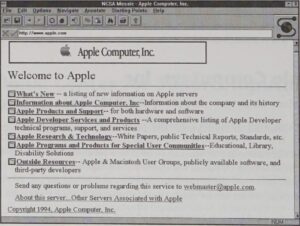
Late 1994 to early 1995 minor changes
Based on William Eager’s 2nd book, the World Wide Web and Mosaic, published in 1995, there were some minor changes to Apple’s site (Figure 3) between Sept 6th 1994 and January 27th 1995. The dates are based on the stock value date mentioned above in the first book (Sept 6th), and a similar screen shot in the second book with a date of 1995-01-27 p515 (Jan 27th), because the stock pages were linked from the Apple site I am assuming the screen captures of Apple’s site were taken at or near the same time.
The book states that at the time the screen shot was taken the main menu offered:
- What’s New
- Information about Apple
- Apple Products and Support
- Apple Developer Services and Products
- Apple Research and Technology
- Apple Programs and Products for Special User Communities
- Outside Resoruces.
Like the 1994 version, about 50 percent of the links opened HTML documents and the other half connected to Gopher menus.
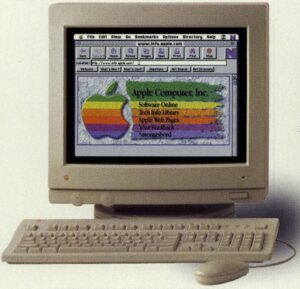
1995 a briefly colourful site
This appears to be a design that was used for Apple’s info.apple.com site, NOT for Apple’s main www.apple.com site.
The design was can be seen in the April 1995 edition of Internet World Vol 06 Num 4 p11 for sessions on setting up World Wide Web services using MacHTTP on Apple’s Workgroup Servers. The image on the screen in the advertisement matches the screenshot found on the version museum that was previously thought to be the earliest screenshot available of Apple’s site. Note: The screen shot appears to show Apple’s website being viewed in Netscape Navigator which was released December 15th 1994.
I also found a screen shot of this version of Apple’s site on page 100 of the 1996 edition of the German book called: Internet & Co.: electronic specialist communication on academic networks.
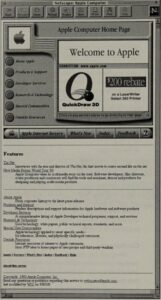
1995 to 1996 metallic gray
By May of 1995 the site was updated to a gray metallic design that likely made use of the newly released Netscape 1.1’s support for tables, this allowed for the creation of the graphical “table based layouts” (used before CSS existed) that were easier to update than a single graphic with image maps.
I thought that this design stayed until early October 1996 based on the cached version on the ARQUIVO.pt site (Oct 10th), and then was replace later that month based on the cached version from October 23rd on the Wayback Machine. But I recently found a screen shot from The World Wide Web for busy people published in 1996 p.170 that shows the same version of Apple’s site as the Wayback Machine, but appears to may been written before October 1996, I was hopping to use the mention of the WWDC starting on May 13th to determine the date, but both the 1996 WWDC and the 1997 WWDC started on May 13th.
For additional versions see the version museum (not the dates on the version museum are not correct, they currently show the “colourful” version as the first version)
1995 Apple launches it’s “other” website: eWorld.com
Apple registered eWorld.com in 1994-01-03 and launched the site between then and June 5th 1997 (first backup in WayBackMachine). It appears to have been a temporary site used to promote Apple’s short lived eWorld service (January 1994 to March 1996) that replaced Apple’s AppleLink service. By April 22nd 1999 (and up until today, 2024-01-03) all requests to eWorld.com are redirected to apple.com.
1996 The Way Back Machine / Arquivo.pt
Links to the earliest captured versions I could find on the Way Back Machine and/or ARQUIVO.pt of each of Apple’s domains
- www.apple.com (1996-10-13): powered by Workgroup Server,
- www.apple.com (1996-10-23), also a graphical site map (1996-10-22)
- asu.info.apple.com (1999-04-23): software updates for apple products
- aspn.apple.com (1998-05-04): Apple Solution Professions Network for consultants, VARs, trainers, systems integrators, and experts in the design and publishing world who provide computer solutions.
- dev.info.apple.com (1996-10-13)
- devcatalog.apple.com (1997-07-15): for ordering Apple-labeled tools, books, CDs and technical resources for development on all Apple platforms.
- devworld.apple.com (1997-01-02): information about how to join the Developers program, in order to receive the Developer Mailings that included Apple’s Developer Newsletters and the Developer CD Series.
- enterprise.apple.com (1997-12-24)
- info.apple.com (1996-10-29)
- research.apple.com (1997-12-10): website of Apple Computer’s Advanced Technology Group, that oversaw the development of concept products and core technologies to be incorporated into future Apple products.
- support.info.apple.com (1996-10-17)
- til.info.apple.com (1997-12-24)
- product.info.apple.com (not captured)
- mirror.apple.com (1996-12-21)
- mission.apple.com (1996-11-11)
- quicktime.apple.com (1996-12-19)
- solutions.apple.com (1996-10-13) (1997-07-01): Information on Apple Internet Server Solutions.
Apple on the Internet before HTML and webpages
Apple has had a presence on the internet before it was called the internet.
1987 Apple registers Apple.com
1987 February: An apple employee, possibly Johan Stranberg (according to Erik Fair, I’ve reached out to Johan on LinkedIn to confirm) registered apple.com by contacting the Stanford Research Institute’s Network Information Centre (SRI-NIC). The cost at the time: free.
A brief history of Domain names:
- 1972 August: RFC384 Official Site Idents for Organizations in the ARPA network which replaces RFC 289 from December 1971
- 1973 December: L. Peter Deutsch published RFC 606 Host Names On-line that suggested an official list of host names be kept in a single location, with further discussions in RFC 608, RFC 623, RFC 625.
- 1974 March: Jake Feinler announced the official list was now online on the Stanford Research Institute’s servers RFC 627 later know as SRI-NIC (10.0.0.73). ARPAnet administrators typically emailed their changes to the Institutes Network Information Centre (NIC) and periodically connected to SRI-NIC and to download the current HOSTS.TXT file via FTP.
- 1983 November: In response to the increasing number of connected systems, Jon Postel, Paul Mockapetris and Craig Partrige published RFC 882 Domain Names – Concepts and Facilities, and RFC 883 Domain Names – Implementation and Specification
- 1984 October: The first set of top level domains were defined by RFC 920 Domain Requirements to be:
- ARPA = The current ARPA-Internet hosts (temporary)
- GOV = Government, any government related domains meeting the second level requirements.
- EDU = Education, any education related domains meeting the second level requirements.
- COM = Commercial, any commercial related domains meeting the second level requirements.
- MIL = Military, any military related domains meeting the second level requirements.
- ORG = Organization, any other domains meeting the second level requirements.
- (alpha-2) = Countries: The English two letter code (alpha-2) identifying a country according the the ISO Standard for “Codes for the Representation of Names of Countries”
1989 July, Apple launches it’s first FTP site
According to the September 1989 CERN document “Developing For the Macintosh Nubus, page 15” by B.G Taylor, Apple Computer opened it’s first public FTP site in July 1989 (apple.apple.com or IP:130.43.2.2). The document states the following directories were available:
- docs: Macintosh technical documentation
- hacks: Useful, unsupported hacks
- mpw: Current Macintosh Programmer’s Workshop (MPW) interface files
- q+a: Macintosh Q&A stack
- sc: Macintosh sample code
- sys.soft: System software information
- tn: Macintosh technical notes.
Because of licensing restrictions, the tools distributed by the Apple Programmers and Developers Association (APDA) were not available from this archive.
1993 Apple launches it’s first Gopher server
During 1993, before HTML pages were the standard for the internet, in addition to it’s FTP site, there was Apple’s Gopher servers.
Based on the screen shot in Navigating the internet by Smith, Richard J 1993 edition on page 145 that includes a link to Apple’s Higher Education Gopher Server, and a note on page 146 that states:
As of June 5th, 1993, there are over 1,300 registered and unregistered Gophers in the world.
I am going to assume that the screenshot appearing on page 145 was created on or before June 5th, 1993.
Other than the screenshot above, TidBITs October 4th 1993 article Newton Internet Resources is the first dated reference I’ve found to Apple’s Higher Education Gopher server. I’m currently searching the internet archive and other sources to see if I can find the exact date when Apple put a Gopher server online.
